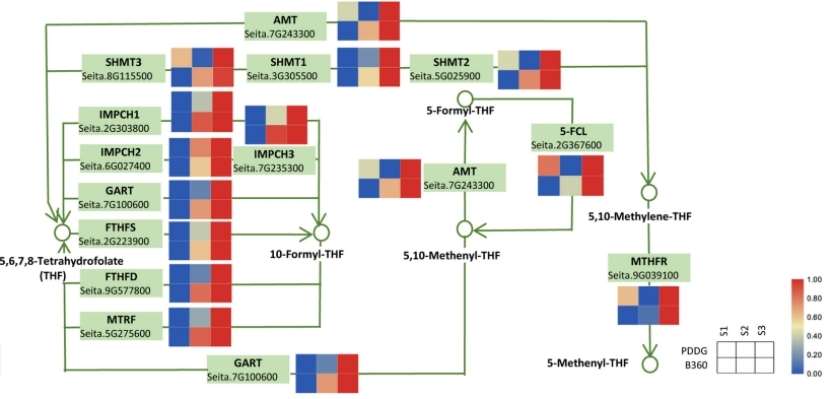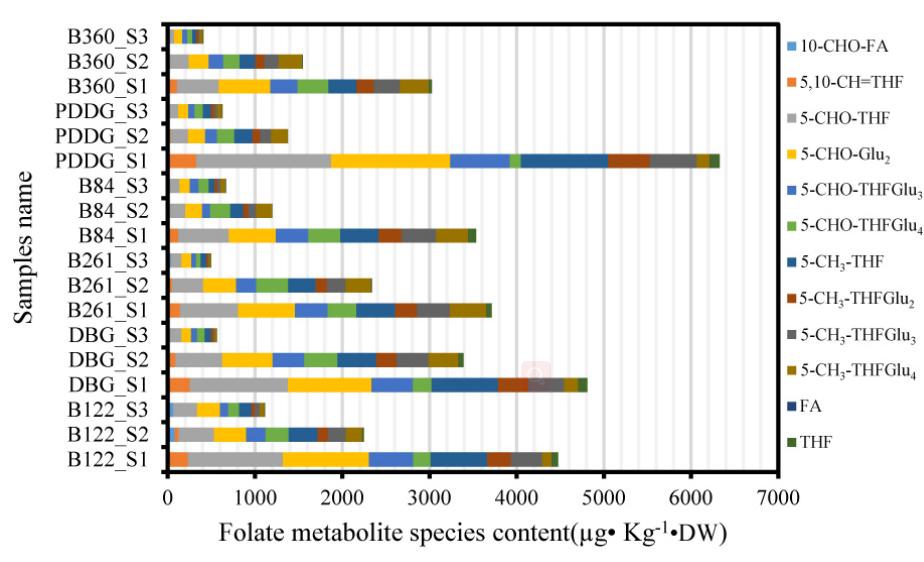What is Folate Metabolism?
Folate, also referred to as folic acid or vitamin B9, is an essential nutrient for plants. It is a water-soluble vitamin that plays a critical role in various metabolic processes. Folate metabolism in plants involves a series of enzymatic reactions that transform dietary folate or folic acid into active forms that can be utilized by cells.
Folate undergoes a series of enzymatic conversions to become biologically active. The initial step involves the reduction of folic acid to dihydrofolate (DHF) by the enzyme dihydrofolate reductase (DHFR). DHF is then further reduced to tetrahydrofolate (THF) by dihydrofolate reductase or other related enzymes. THF serves as a central intermediate in folate metabolism and participates in various metabolic reactions. It acts as a coenzyme in one-carbon transfer reactions, which are involved in the synthesis of nucleotides, amino acids, and other essential molecules. THF accepts and donates one-carbon units in these reactions, facilitating the transfer of methyl, formyl, and methylene groups.
One important reaction in folate metabolism is the conversion of THF to methyltetrahydrofolate (MTHF). This reaction is catalyzed by the enzyme methylenetetrahydrofolate reductase (MTHFR). MTHF is a critical donor of methyl groups in the synthesis of methionine, an amino acid involved in protein synthesis and other vital cellular processes.
Folate metabolism in plants is tightly regulated to maintain optimal folate levels. The expression and activity of the enzymes involved in folate metabolism are regulated by various factors, including environmental cues, nutrient availability, and developmental stages. This ensures that plants can efficiently utilize folate for their growth, development, and overall metabolic processes.
Understanding folate metabolism in plants is essential for optimizing plant growth, enhancing crop yields, and improving plant nutritional quality. It also provides insights into the impact of folate on plant responses to environmental stresses and the interactions between folate and other metabolic pathways.
Folate Metabolism Analysis at Creative Proteomics
Folate metabolite profiling: This service provides a comprehensive analysis of folate metabolites in biological samples. Using cutting-edge mass spectrometry-based techniques, such as liquid chromatography-mass spectrometry (LC-MS) or gas chromatography-mass spectrometry (GC-MS), Creative Proteomics can identify and quantify a wide range of folate metabolites present in various sample types.
Stable isotope tracing studies: Creative Proteomics offers stable isotope labeling studies to investigate folate metabolism dynamics. By utilizing stable isotopes, such as deuterium or ^13C-labeled folate, metabolic flux analysis can be performed to determine the rates of folate turnover and folate-dependent reactions in different biological systems.
Enzyme activity assays: This service focuses on measuring the activity of enzymes involved in folate metabolism, such as dihydrofolate reductase (DHFR) and methylenetetrahydrofolate reductase (MTHFR). These assays provide valuable insights into the functional aspects of folate metabolism and its regulation.
Techniques for Folate Metabolism Analysis
Liquid chromatography-tandem mass spectrometry (LC-MS/MS): LC-MS/MS combines the high separation efficiency of liquid chromatography with the sensitivity and selectivity of tandem mass spectrometry. It enables the identification and quantification of folate metabolites with high precision and accuracy.
Gas chromatography-mass spectrometry (GC-MS): GC-MS is particularly useful for volatile or thermally stable folate metabolites. This technique involves the separation of metabolites by gas chromatography followed by their detection and identification using mass spectrometry.
High-resolution mass spectrometry (HRMS): HRMS provides superior mass accuracy and resolution, allowing for the detection of a broad range of folate metabolites and their isotopologues. It enables comprehensive profiling and structural characterization of folate metabolites in complex samples.
The specific instrument models employed at Creative Proteomics for folate metabolism analysis include:
- LC-MS/MS: Thermo Scientific™ Q Exactive™ series, AB SCIEX TripleTOF® series, Waters Xevo™ series.
- GC-MS: Agilent 7890A GC system coupled with Agilent 5977A or 5975C MSD.
 Workflow for Plant Metabolomics Service
Workflow for Plant Metabolomics Service
List of Folate Metabolites Analyzed (including but not limited to)
| Category |
Folate Metabolites |
| Monoglutamates |
5-Methyl-THF, 5-Formyl-THF, THF, DHF |
| Polyglutamates |
5-Methyl-THF-Glu1-7, 5-Formyl-THF-Glu1-7, THF-Glu1-7, DHF-Glu1-7 |
| Cofactors |
Methylcobalamin, MTHF, N5, N10 -Methylene-THF |
| Intermediates |
10-Formyl-THF, 5,10-Methenyl-THF, 5-Formimino-THF |
| Excreted forms |
Pterin, PABA (Para-aminobenzoic acid) |
Why Need Folate Metabolism Analysis?
Nutritional studies: By quantifying folate levels, researchers can assess the nutritional value of plants and determine how folate content varies across varieties or under different growing conditions, helping to design strategies to increase folate levels in crops and enhance human nutrition.
Biosynthesis and regulation of folate: The metabolic pathways and enzymatic steps involved in folate synthesis are revealed by studying the levels of different folate intermediates and cofactors. Understanding the regulation of folate metabolism can help manipulate folate levels in plants for a variety of purposes, such as increasing resistance to environmental stress or improving agronomic traits.
Impact of environmental factors: Folate metabolism in plants is influenced by a variety of environmental factors, including light, temperature, nutrient availability, and biotic/abiotic stresses. Folate analysis enables the study of how these environmental factors affect folate levels and the distribution of folate in different plant tissues, contributing to the understanding of adaptive plant responses to changing environmental conditions and the development of resilience and crop improvement strategies.
Folate transport and compartmentalization: By determining folate levels in different organelles and subcellular compartments, it is possible to gain insights into the mechanisms and regulation of folate transport, and to understand the roles of different compartments in folate metabolism and their impact on overall plant physiology.
Interaction with other metabolites: Folate metabolism is interconnected with various other metabolic pathways in plants. Folate analysis allows researchers to study the interactions between folate and other metabolites, such as amino acids, nucleotides, and phytohormones, to understand the metabolic crossover and regulatory networks that underlie plant growth, development, and response to environmental stimuli.
Sample Requirements for Folate Metabolism Assay
| Sample Types |
Minimum Sample Size |
Biological Repeat |
| Plant Samples |
Roots, stems and leaves, floral parts, fruits/seeds, rhizomes, buds/tender leaves, tissue sections, pollen, bark, trunk/wood, resin/gum, resin acids, seedlings/young plants, rhizosphere soil, root exudates. |
100 mg - 1 g |
3-6 |
| Animal Samples |
Blood/plasma
Tissues |
100-500 μL
100-500 mg |
Humans >30/group
Animals 8-10/group |
| Cell Samples |
Cultured cells
cell lysates |
1×107
100-500 μL |
Humans >30/group
Animals 8-10/group |
Case 1. Folate Metabolite Analysis in Foxtail Millet Panicles: Insights into Developmental Changes and Gene Expression Correlations
Background:
Folate metabolism plays a crucial role in various biological processes and is essential for human and animal health. Folate-rich foods are necessary to meet daily dietary requirements since folates are not synthesized in the body. Deficiencies or imbalances in folate metabolism can lead to several health issues, including neural tube defects, cardiovascular diseases, and cognitive impairments. Therefore, studying folate metabolism and analyzing folate metabolites is of great importance for understanding its role in human health and developing strategies to improve folate intake.
Sample:
In this study, foxtail millet (Setaria italica) panicles were used as the plant material for folate metabolite analysis. A total of six cultivars ('B360', 'DBG', 'B261', 'B84', 'PDDG', and 'B122') with similar growth cycles and panicle shapes were selected for the experiments. Ten plants from each cultivar were grown in the greenhouse under controlled conditions. Panicles were harvested at different stages of development, namely S1 (grain-filling stage), S2 (grain middle maturation stage), and S3 (grain maturation stage).
Technical Platform and Procedure:
The analysis of folate metabolites in foxtail millet panicles was conducted using liquid chromatography-mass spectrometry (LC-MS) techniques. The LC-MS method allowed for the detection and quantification of 12 different folate metabolites. Standard curves were constructed using different concentrations of folate standards to establish a correlation between concentration and peak area. The samples were prepared by extracting folate metabolites from dried and ground panicle powder using a specific extraction solution. The extracted samples were then subjected to chromatographic analysis using an HPLC system with specific parameters and conditions.
Results
The analysis of folate metabolites in foxtail millet panicles revealed interesting findings. The total folate content showed a gradual decrease from the S1 to S3 stage in all six cultivars. The most abundant folate metabolite species detected during panicle development were 5-CHO-THF and 5-CHO-THFGlu2. The correlation analysis between folate metabolite concentrations and gene transcript levels identified significant associations between specific folate metabolites and gene expression. SiADCL1 and SiGGH gene transcript levels showed positive correlations with total folate content. On the other hand, Si5-FCL and SiIMPCH2 transcript levels showed negative correlations with certain folate metabolites.


Reference
- Hou, Siyu, et al. "Folate metabolic profiling and expression of folate metabolism‐related genes during panicle development in foxtail millet (Setaria italica (L.) P. Beauv)." Journal of the Science of Food and Agriculture 102.1 (2022): 268-279.


 Workflow for Plant Metabolomics Service
Workflow for Plant Metabolomics Service

